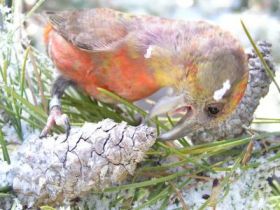Idaho: New Bird Species Discovered
Posted by: Loren Coleman on March 19th, 2007

A male South Hills crossbill using its crossed mandibles to bite between lodgepole pine cone scales to access seeds. The decurved mandibles enable crossbills to exert strong biting forces at the tip of their bill. Credit: (photograph by Craig Benkman)
One does not expect to discover a bird species new to science while wandering around the continental United States. Nor does one expect that such a species would provide much insight into how coevolutionary arms races promote speciation. On both fronts a paper to appear in The American Naturalist proves otherwise.
Julie Smith, now at Pacific Lutheran University, and her former graduate advisor, Craig Benkman at the University of Wyoming, have uncovered strong evidence that coevolution has led to the formation of a species of bird new to science in the continental United States. Benkman discovered in 1996 what appears to be a new species restricted to two small mountain ranges in southern Idaho (the South Hills and Albion Mountains). This species is a morphologically and vocally distinct “call type” of red crossbill (Loxia curvirostra complex), which is a group of seed-eating finches specialized for extracting seeds from conifer cones.
Fieldwork by Smith has revealed some of the mechanisms that have contributed to the nearly complete cessation of interbreeding between this crossbill and other call types that move into the South Hills every year. Perhaps most remarkable is that this new crossbill evolved because of a coevolutionary arms race between crossbills and lodgepole pine (Pinus contorta) in the last five to seven thousands years.
As South Hills crossbills exerted selection on lodgepole pine for increased seed defenses, lodgepole pine in turn exerted selection on crossbills for larger bills to deal with these increased seed defenses. This coevolution has caused these crossbills to diverge substantially in bill morphology from other crossbills. Because the South Hills crossbill is adapted to remove seeds from the well-defended cones there, it is a superior competitor and thereby limits the less well adapted and nomadic call types to breeding at very low frequencies in the South Hills.
Such ecological differences lead to premating (i.e., before mating) reproductive isolation, which is nearly completed by strong assortative pairing among the different call types (>99% of South Hills crossbills pair with another South Hills crossbill). “This indicates that levels of reproductive isolation characteristic of recognized species can evolve rapidly even in the continued face of potential gene flow” says Benkman. It also shows that coevolution can be a potent force for rapidly generating biodiversity.
Credit: Julie W. Smith and Craig W. Benkman, “A coevolutionary arms race causes ecological speciation in crossbills” American Naturalist. 2007. 169:455-465. University of Chicago Press Journals/PhysOrgForum
About Loren Coleman
Loren Coleman is one of the world’s leading cryptozoologists, some say “the” leading living cryptozoologist. Certainly, he is acknowledged as the current living American researcher and writer who has most popularized cryptozoology in the late 20th and early 21st centuries.
Starting his fieldwork and investigations in 1960, after traveling and trekking extensively in pursuit of cryptozoological mysteries, Coleman began writing to share his experiences in 1969. An honorary member of Ivan T. Sanderson’s Society for the Investigation of the Unexplained in the 1970s, Coleman has been bestowed with similar honorary memberships of the North Idaho College Cryptozoology Club in 1983, and in subsequent years, that of the British Columbia Scientific Cryptozoology Club, CryptoSafari International, and other international organizations. He was also a Life Member and Benefactor of the International Society of Cryptozoology (now-defunct).
Loren Coleman’s daily blog, as a member of the Cryptomundo Team, served as an ongoing avenue of communication for the ever-growing body of cryptozoo news from 2005 through 2013. He returned as an infrequent contributor beginning Halloween week of 2015.
Coleman is the founder in 2003, and current director of the International Cryptozoology Museum in Portland, Maine.










Darwin at work, perhaps more finches will be recognized as separate species.
The paper in its entirety can be viewed freely at “A Coevolutionary Arms Race Causes Ecological Speciation in Crossbills.”
While over there take a look at “Are Species Adapted to Their Regeneration Niche, Adult Niche, or Both?” by Lourens Poorter and “Clade Age and Not Diversification Rate Explains Species Richness among Animal Taxa” by Mark A. McPeek and Jonathan M. Brown.
Both these are interesting looks at species and taxonomic creations, status and breakouts.
Craig Heinselman
Peterborough, NH
I have heard of that sort of specialization before. I think it is amazing. But I guess it is just a matter of the ones that cannot perform the task (for instance removing of fortified conifer seeds) in the specialized area either dying off or moving on. I mean they don’t really change for the task or environment, just that more with longer beaks survive, eventually the area only supports birds “with beak enough” for surviving. Very cool.
Thats what i search,thanks JustinC
Survival of the “beakiest”.
Imagine what those seeds and birds will look like in one thousand years, as the trees continue to develop stronger defenses and the birds keep exhibiting ever more powerful beaks and associated musculature.
Ten thousand years?
A similar species split happened with the Common Crossbill (Loxia curvirostra) and the Scottish Crossbill (Loxia scotia) a few years ago here in the UK.
The ‘new’ Scottish Crossbill is Britain’s only endemic bird species.
I remember hearing that some of the species of finches Darwin observed numbers dwindled and now more than one specie of finch is cross breeding. I might have missed it above, but are there no other birds that at least attempt getting the pine nuts?